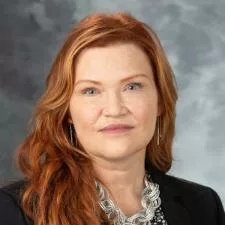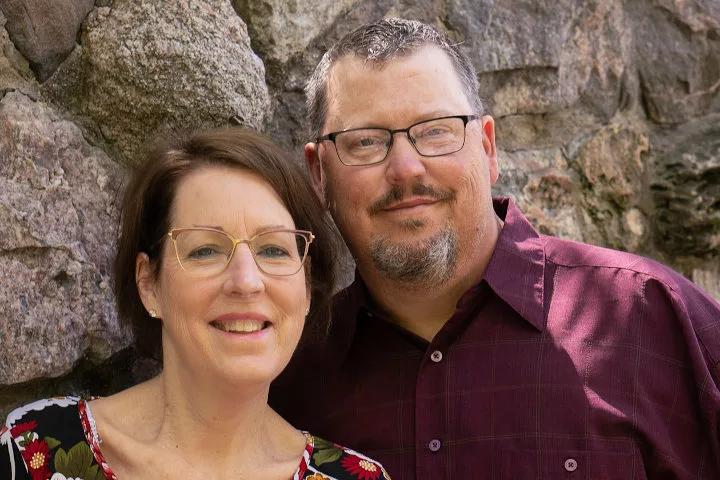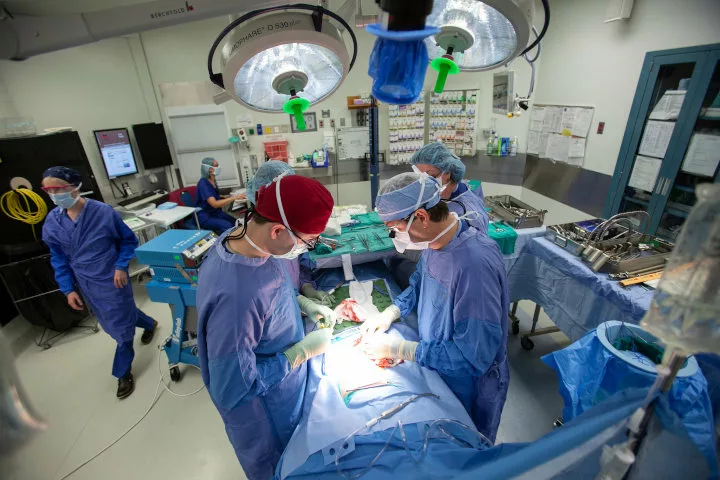Grateful Transplant Recipient Pleasant T. Rowland Gives Back to UW
A $10 million gift will support creation of the Pleasant T. Rowland Transplant Clinic, which will be located near the main entrance of University Hospital.
Fifty-five years ago, a handful of surgeons and nephrologists began performing kidney transplants at University Hospital in Madison, Wisconsin. The program’s momentum stalled when the lead surgeon, William Kisken, MD (PG ’63), asked that transplantation receive its own divisional status, and he chose to leave when leaders denied his request.
Other surgeons continued performing transplants, and in 1974, when Folkert Belzer, MD, joined the faculty of the University of Wisconsin School of Medicine and Public Health (SMPH) as the new chair of the Department of Surgery, he set his sights on building a world-class transplant program.

He succeeded — and then some. The program grew to include heart, pancreas, liver and lung transplantation; renal auto transplantation; pediatric kidney, liver, pancreas and lung transplantation; and living kidney and liver donation. In 2020, UW Organ and Tissue Donation (UW OTD), the Human Leukocyte Antigen (HLA) Lab and the organ-specific programs (such as the UW Health Lung Transplant Program) were all united under a single umbrella — the UW Health Transplant Center. Dixon Kaufman, MD, PhD, FACS, is the center’s medical director, and Melissa Roberts, MSN, RN, is the executive administrative director. The center also benefits from the support of Ric Ransom, MSHA, MBA, JD, president, UW Hospitals – Madison Region; Aimee Becker, MD, MBA, chief medical officer, UW Health; and other leaders at the SMPH and UW Health.

The UW Health Transplant Center is one of the largest and most comprehensive of its kind in the nation. In 2020, a record 548 patients received transplants, even though the COVID-19 pandemic forced University Hospital to shut down its Transplant Center for several weeks. In October 2020, UW Health was the first facility in Wisconsin to perform a double-lung transplant on a person who experienced lung damage due to COVID-19. Researchers at the center also continue to study new ways to expand the donor pool, decrease patients’ immune responses to their new organs and help transplant recipients live longer.
As the center has grown, so, too, has its ability to better match organ donors and recipients and serve both donor families and living donors. The HLA Lab studies donors’ and recipients’ human leukocyte antigens (genetic markers) to determine whether an organ would be a good match. When personnel at the UW Health Transplant Center learn about a deceased donor, an HLA Lab staff member evaluates the donor’s specific human leukocyte antigens so the United Network for Organ Sharing (UNOS) can find the best match. The lab also works with recipients and living donors to determine their unique HLAs.
Meanwhile, the UW OTD helps facilitate the process of deceased organ donation, and staff members work closely with grieving families before, during and long after their loved one’s donation. The team focuses heavily on education, working with more than 100 hospitals in Wisconsin, Michigan and Illinois to serve donors and their families. It deploys dozens of volunteers and staff members to community events across their service area, always seeking to increase the number of registered organ donors.
While researchers explore new ways to expand the donor pool, they are performing transplants with organs that otherwise might have been deemed unusable. They accomplish this through the use of warm organ preservation. For decades, transplant staff have used a cold solution — called the “UW Solution,” which was developed by Belzer and colleagues at University Hospital — to keep organs healthy while they were transporting them from donor to recipient; the technique was groundbreaking in its era. The new warm preservation method, however, can extend the life of livers, lungs and hearts during the transfer process, giving doctors a potentially longer period between donation and transplantation. This technique keeps hearts beating and lungs “breathing” while doctors assess the organs to ensure they are appropriate for transplantation.
Warm preservation also can lead to the increased utilization of deceased donor organs that may otherwise be discarded. The enhanced utilization leads to increased transplant rates and decreased mortality for patients on the transplant list. Take Sandy Malay, for example. She and three of her five siblings have the gene for hypertrophic cardiomyopathy, a disease that makes it harder for the heart to pump blood to the rest of the body. She was on the wait list for a new heart at another transplant center, but doctors there told her she may have to wait several years for her turn. In the meantime, her brother, Mark Graff, moved quickly through the transplant process: He was put on the wait list for a heart at UW Health in March 2020, and by May, he received the gift of life. He recommended that Malay pursue dual listing, which she did, and just a month after she got on the list at UW Health, she received her new heart.

Malay’s wait was so short because UW Health was one of the nation’s first centers involved in a clinical trial using donation after circulatory death (DCD) hearts. As part of the DCD process, organs are retrieved from a patient after his or her heart stops. Health care professionals then use warm perfusion to assess the organ’s viability, essentially “reanimating” it for use in another person. The study, led by Jason Smith, MD, FACS, a heart transplant surgeon and SMPH associate professor of medicine, has the potential to radically increase the number of donor hearts that are available and, thus, save more lives.
Meanwhile, Malay and Graff are living their best lives with their DCD hearts. While their two siblings with the gene have not reached the point of being listed for a heart transplant, they have switched their care to UW Health and are seeing Maryl Johnson, MD, FACC, SMPH professor of medicine and one of the cardiologists who treats Malay and Graff.
Deceased organ donation is an incredible gift, but studies have shown that living kidney donation results in even better outcomes for transplant recipients. The UW Health Transplant Center has been serving living kidney donors for more than 50 years and continues to expand its program. Previously, a transplant patient could receive a kidney from a living donor only if he or she had a willing donor who was a good match. Now, however, the National Kidney Registry (NKR) facilitates paired exchanges, during which pairs of donors and recipients enter a chain with other pairs so recipients can receive the best match possible. In fact, UW Health is the largest and most active kidney donation program that works with the NKR.

Over the last several years, kidney exchanges have become ever more complex — which is a big win for people who desperately need a healthy kidney. Not only are the chains longer (some of the longest involve more than 30 pairs), but UW Health also has implemented a kidney voucher program. A living donor can donate a kidney on behalf of a specific recipient at a time that is convenient for that person to donate, with the understanding that the recipient will receive a kidney from another living donor when he or she is ready for it — which may be months to years later.
Additionally, living liver donation continues to be a good option for transplant patients who might otherwise have to wait years for a deceased donor organ. After years of success serving living liver donors, UW Health recently started a non-directed living liver donation program, during which people can donate a portion of their livers to be given to recipients on the transplant waiting list.
For many years, UW Health has treated children who need kidney and liver transplants. Recently, the center began offering pediatric pancreas and lung transplants, and in September 2021, a new pediatric cardiologist will come on board to launch the Pediatric Heart Transplant Program. At that time, University Hospital will become a member of an exclusive group — a comprehensive adult and pediatric center that transplants all solid organs.
All the advancements at the SMPH and UW Health are possible only because of arduous research. The UW Health Transplant Center is one of the leading research institutions in the country. Researchers from every transplant program are investigating methods of increasing the donor pool, preserving organs and decreasing the immune response. At any given time, the academic medical center is offering several clinical trials for patients. For example, UW Health was part of a clinical trial that allows patients to substitute belatacept, an anti-rejection drug, for calcineurin inhibitors and the need for chronic use of steroids. One such steroid, prednisone, causes infamous side effects, including weight gain, mood swings and insomnia. Belatacept now is a superior alternative for many patients who want to decrease the number of anti-rejection medications they take.
In addition to traditional organ transplant, UW Health has become the foremost center in the United States for renal auto transplant. The procedure, which involves removing the patient’s kidney and replacing it lower in that person’s abdomen, is used to treat patients who have chronic flank pain. Many such patients have suffered from unbearable pain for years because of conditions such as nutcracker syndrome, which occurs when an artery in the abdomen squeezes the left renal vein. UW Health experts pioneered the use of renal auto transplant to treat these patients, and it has become the hospital of choice for many people — usually women — who suffer from these debilitating problems.
The UW Health Transplant Center has been going strong for 55 years, and while it has become renowned for many world-class innovations, physicians and researchers aren’t resting on their laurels. Rather, they’re looking to the future — to the possibility that they can treat more patients, recover more organs, eliminate more complications and save more lives.